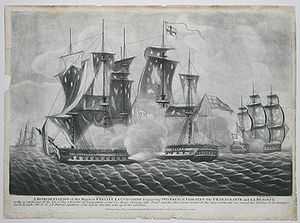French frigate Résolue (1778)
 Engageante (left) and Résolue (right) battling HMS Concorde at the Action of 23 April 1794 | |
| Career (France) | |
|---|---|
| Name: | Résolue |
| Namesake: | Resolute |
| Builder: | Lemarchand, Saint Malo; plans by Léon-Michel Guignace |
| Laid down: | April 1777 as No. 1 |
| Launched: | 16 March 1778 |
| In service: | April 1778 |
| Captured: | 14 October 1798 |
| Career (UK) | |
| Name: | Resolue |
| Acquired: | 14 October 1798 |
| Fate: |
Hulk in Plymouth Broken up 1811 |
| General characteristics [1] | |
| Class and type: | Iphigénie-class frigate |
| Displacement: | 1,150 tons (French) |
| Tons burthen: | 877 27⁄94 (bm) |
| Length: | 140 ft 2 in (42.72 m) (overall); 116 ft 3 in (35.43 m) (keel) |
| Beam: | 37 ft 8 in (11.48 m) |
| Draught: | 4.9 m (16 ft) (unladen) |
| Sail plan: | Full-rigged ship |
| Complement: | French service:270-290 British service:54 (as receiving ship) |
| Armament: | French service: 26 × 12-pounder guns + 6 × 6-pounder guns; between 1793 and 1795 she also had 2 × 36-pounder obusiers, and between 1796 and 1798 she also had 4 × 36-pounder obusiers[2] British service:28 × 18-pounder guns + 4 × 6-pounder guns |
Résolue was an Iphigénie-class 32-gun frigate of the French Navy. The British captured her twice, once in November 1791 during peacetime, and again in 1798. The Royal Navy hulked her in 1799 and she was broken up in 1811.
French service
In January 1779, Résolue was part of a squadron under Admiral Vaudreuil that captured Fort St Louis in Senegal from the British in February. The troops were under the command of the Duc de Lauzun. In September she was at Martinique undergoing repairs and refitting.[2]
In April 1781 Résolue was at Brest, being coppered. In 1783 she was again at Brest for repairs.[2]
In November 1791, as she was escorting merchant ships, Résolue was captured at the Battle of Tellicherry by HMS Phoenix and HMS Perseverance. She suffered 25 men killed and 40 wounded. As this occurred during peacetime, the British restored her to France at Mahé.[2] In 1793 she was at Brest being repaired.[2]
She took part in the Action of 23 April 1794, when a squadron comprising Résolue, Engageante, Pomone and the 22-gun corvette Babet met a squadron of five British heavy frigates. Résolue managed to escape but the British took the other three ships.
She took part in the Expédition d'Irlande, under captain Montalan. On 22 December 1796, she collided with Redoutable in Bantry Bay, dismasting her. A boat was sent to seek help from Immortalité, but it was washed up on the shore on Clough Beach and its crew taken prisoner. The boat is now a local attraction. Résolue managed to return to Brest under emergency rigging and in tow from Pégase.
Capture
HMS Melampus captured Résolue on 14 October 1798 at the Battle of Tory Island. Résolue was fitted with hanging ports to her main deck. To meet a coming storm, her crew had run in and double-breeched her 12-pounders, and shut and barred the ports. She was, therefore, in a comparatively defenseless state with only her quarterdeck guns able to respond to Melampus 's broadsides. Before she struck her colours, Résolue lost ten men killed and had some wounded, out of about 500 men on board.[3]
British career
She was purchased for the Royal Navy as HMS Resolue but never saw active service, instead being hulked in 1799 at Plymouth. Resolue was commissioned under Lieutenant D. Wynter in November 1801. His replacement was Lieutenant T. Richards. She was in ordinary in 1802. She was again commissioned, in April 1803, under Lieutenant J.H. Nicols, as a slop ship. In 1807 she served as flagship for Admiral J. Sutton. In 1809 she was a receiving ship.[4] As late as 1810 she did have men aboard, including some African-Americans impressed into service, who wrote letters attempting to secure their release.[5]
Fate
Resolue was broken up on 10 August 1811.[1]
Citations
- ↑ 1.0 1.1 Winfield (2008), p.209.
- ↑ 2.0 2.1 2.2 2.3 2.4 Demerliac (1996), p.62, #374.
- ↑ James (1837), Vol. 2, pp. 135-7.
- ↑ "NMM, vessel ID 374480" (PDF). Warship Histories, vol iii. National Maritime Museum. Retrieved 30 July 2011.
- ↑ W. Jeffrey Bolster. 2007. Notes and Documents: Letters by African American Sailors, 1799–1814. The William and Mary Quarterly, vol. 64, no. 1.
References
- Colledge, J.J. Ships of the Royal Navy: The Complete Record of All Fighting Ships of the Royal Navy From the Fifteenth Century to the Present. Annapolis, Maryland: Naval Institute Press, 1987. ISBN 0-87021-652-X.
- Demerliac, Alain (1996) La Marine De Louis XVI: Nomenclature Des Navires Français De 1774 À 1792. (Nice: Éditions OMEGA). ISBN 2-906381-23-3
- James, William (1837). The Naval History of Great Britain, from the Declaration of War by France in 1793, to the Accession of George IV. R. Bentley.
- Winfield, Rif. British Warships in the Age of Sail, 1793-1817: Design, Construction, Careers and Fates. Seaforth Publishing, 2nd edition, 2008. ISBN 978-1-84415-717-4.
- Winfield, Rif & Stephen S Roberts (2015 Forthcoming) French Warships in the Age of Sail 1786 - 1862: Design Construction, Careers and Fates. (Seaforth Publishing). ISBN 9781848322042
External links
| ||||||||||
This article includes data released under a Creative Commons Attribution-ShareAlike 3.0 Unported UK: England & Wales License, by the National Maritime Museum, as part of the Warship Histories project